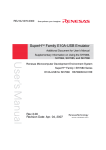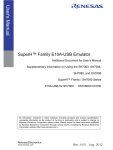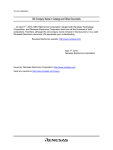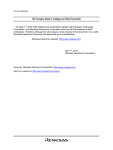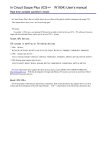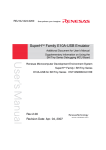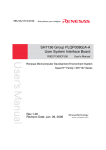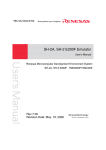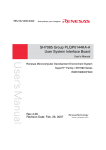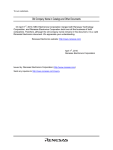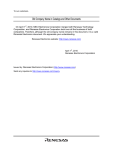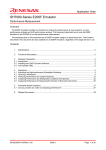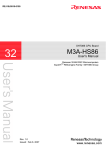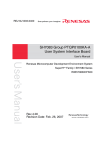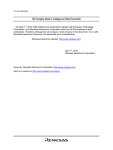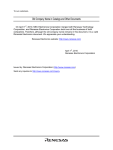Download SH-2A, SH-2 E200F Emulator Additional Document for
Transcript
REJ10J1237-0400 SH-2A, SH-2 E200F Emulator Additional Document for User’s Manual Supplementary Information on Using the SH7083, SH7084, SH7085, SH7086, SH7146, SH7149, SH7124, and SH7125 Renesas Microcomputer Development Environment System SuperH™ Family / SH7080 Series / SH7146 Series / SH7125 Series E200F for SH7080 R0E570800EMU00E Rev.4.00 Revision Date: Feb. 26, 2007 Notes regarding these materials 1. This document is provided for reference purposes only so that Renesas customers may select the appropriate Renesas products for their use. Renesas neither makes warranties or representations with respect to the accuracy or completeness of the information contained in this document nor grants any license to any intellectual property rights or any other rights of Renesas or any third party with respect to the information in this document. 2. Renesas shall have no liability for damages or infringement of any intellectual property or other rights arising out of the use of any information in this document, including, but not limited to, product data, diagrams, charts, programs, algorithms, and application circuit examples. 3. You should not use the products or the technology described in this document for the purpose of military applications such as the development of weapons of mass destruction or for the purpose of any other military use. When exporting the products or technology described herein, you should follow the applicable export control laws and regulations, and procedures required by such laws and regulations. 4. All information included in this document such as product data, diagrams, charts, programs, algorithms, and application circuit examples, is current as of the date this document is issued. Such information, however, is subject to change without any prior notice. Before purchasing or using any Renesas products listed in this document, please confirm the latest product information with a Renesas sales office. Also, please pay regular and careful attention to additional and different information to be disclosed by Renesas such as that disclosed through our website. (http://www.renesas.com ) 5. Renesas has used reasonable care in compiling the information included in this document, but Renesas assumes no liability whatsoever for any damages incurred as a result of errors or omissions in the information included in this document. 6. When using or otherwise relying on the information in this document, you should evaluate the information in light of the total system before deciding about the applicability of such information to the intended application. Renesas makes no representations, warranties or guaranties regarding the suitability of its products for any particular application and specifically disclaims any liability arising out of the application and use of the information in this document or Renesas products. 7. With the exception of products specified by Renesas as suitable for automobile applications, Renesas products are not designed, manufactured or tested for applications or otherwise in systems the failure or malfunction of which may cause a direct threat to human life or create a risk of human injury or which require especially high quality and reliability such as safety systems, or equipment or systems for transportation and traffic, healthcare, combustion control, aerospace and aeronautics, nuclear power, or undersea communication transmission. If you are considering the use of our products for such purposes, please contact a Renesas sales office beforehand. Renesas shall have no liability for damages arising out of the uses set forth above. 8. Notwithstanding the preceding paragraph, you should not use Renesas products for the purposes listed below: (1) artificial life support devices or systems (2) surgical implantations (3) healthcare intervention (e.g., excision, administration of medication, etc.) (4) any other purposes that pose a direct threat to human life Renesas shall have no liability for damages arising out of the uses set forth in the above and purchasers who elect to use Renesas products in any of the foregoing applications shall indemnify and hold harmless Renesas Technology Corp., its affiliated companies and their officers, directors, and employees against any and all damages arising out of such applications. 9. You should use the products described herein within the range specified by Renesas, especially with respect to the maximum rating, operating supply voltage range, movement power voltage range, heat radiation characteristics, installation and other product characteristics. Renesas shall have no liability for malfunctions or damages arising out of the use of Renesas products beyond such specified ranges. 10. Although Renesas endeavors to improve the quality and reliability of its products, IC products have specific characteristics such as the occurrence of failure at a certain rate and malfunctions under certain use conditions. Please be sure to implement safety measures to guard against the possibility of physical injury, and injury or damage caused by fire in the event of the failure of a Renesas product, such as safety design for hardware and software including but not limited to redundancy, fire control and malfunction prevention, appropriate treatment for aging degradation or any other applicable measures. Among others, since the evaluation of microcomputer software alone is very difficult, please evaluate the safety of the final products or system manufactured by you. 11. In case Renesas products listed in this document are detached from the products to which the Renesas products are attached or affixed, the risk of accident such as swallowing by infants and small children is very high. You should implement safety measures so that Renesas products may not be easily detached from your products. Renesas shall have no liability for damages arising out of such detachment. 12. This document may not be reproduced or duplicated, in any form, in whole or in part, without prior written approval from Renesas. 13. Please contact a Renesas sales office if you have any questions regarding the information contained in this document, Renesas semiconductor products, or if you have any other inquiries. Contents Section 1 System Configuration ............................................................................1 1.1 1.2 Components of the Emulator ................................................................................................. 1 System Configuration ............................................................................................................ 8 Section 2 Connecting the Emulator to the User System ......................................11 2.1 2.2 2.3 2.4 2.5 2.6 Connecting the Emulator to the User System ...................................................................... 11 Connecting the Emulator to the User System by Using the EV-chip Unit........................... 11 2.2.1 Connecting the EV-chip Unit to the Emulator ........................................................ 11 2.2.2 Connecting the E200F External Bus Trace Unit to the EV-chip Unit .................... 14 2.2.3 Connecting the Probe Head to the EV-chip Unit .................................................... 16 2.2.4 Connecting the E200F Emulation Memory Unit to the EV-chip Unit.................... 17 2.2.5 Connecting the E200F External Bus Trace Unit, Emulation Memory Unit, and EV-chip Unit .................................................................................................... 19 2.2.6 Connecting the EV-chip Unit to the User System Interface Board......................... 20 Connecting the Emulator to the User System by Using the H-UDI Port Connector............ 21 Installing the H-UDI Port Connector on the User System ................................................... 22 Pin Assignments of the H-UDI Port Connector ................................................................... 22 Recommended Circuit between the H-UDI Port Connector and the MCU ......................... 24 2.6.1 Recommended Circuit (36-Pin Type) ..................................................................... 24 Section 3 Software Specifications when Using the SH7080 Series/ SH7146 Series/SH7125 Series.............................................................27 3.1 3.2 Differences between the MCU and the Emulator ................................................................ 27 Specific Functions for the Emulator when Using the SH7080 Series/SH7146 Series/ SH7125 Series...................................................................................................................... 35 3.2.1 Event Condition Functions ..................................................................................... 35 3.2.2 Trace Functions....................................................................................................... 42 3.2.3 Notes on Using the JTAG (H-UDI) Clock (TCK) and AUD Clock (AUDCK)...... 55 3.2.4 Notes on Setting the [Breakpoint] Dialog Box ....................................................... 56 3.2.5 Notes on Setting the [Event Condition] Dialog Box and the BREAKCONDITION_ SET Command ........................................................... 56 3.2.6 Performance Measurement Function ...................................................................... 57 Section 4 User System Interface Circuits ............................................................61 4.1 4.2 User System Interface Circuits............................................................................................. 61 User System Interface Board Circuits.................................................................................. 73 i 4.3 ii Delay Time for the User System Interface........................................................................... 79 Section 1 System Configuration 1.1 Components of the Emulator The E200F emulator supports the SH7080 series, SH7146 series, and SH7125 series: SH7083 (R5E SH7083 (R5E70835R/R5F70834A/R5F70835A), SH7084 (R5E70845R/R5F70844A/R5F70845A), SH7085 (R5E70855R/ R5F70854A/R5F70855A), SH7086 (R5E70865R/R5F70865A), SH7146 (R5E71464R/R5F71464R), SH7149 (R5E71494R/R5F71494R/R5E71491R/R5F71491R), SH7124, and SH7125. Table 1.1 lists the components of the emulator. 1 Table 1.1 Components of the Emulator Classification Component Hardware Emulator main unit AC adapter Appearance Quantity 1 Remarks R0E0200F1EMU00: Depth: 195.0 mm, Width: 130.0 mm, Height: 45.0 mm, Mass: 490.0 g Product numbers: 0001 to 0113 1 Input: 100 to 240 V Output: 12 V 4.0 A Depth: 120.0 mm, Width: 72.0 mm, Height: 27.0 mm, Mass: 400.0 g Product numbers: 0114 or later 1 Input: 100 to 240 V Output: 12 V 3.0 A Depth: 99.0 mm, Width: 62.0 mm, Height: 26.0 mm, Mass: 270.0 g AC cable 2 1 Length: 2000 mm Table 1.1 Components of the Emulator (cont) Classification Component Hardware (cont) USB cable External probe Appearance Quantity Remarks 1 Length: 1500 mm, Mass: 50.6 g Product numbers: 0001 to 0113 1 Length: 500 mm, Pins 1 to 4: probe input pins, T: trigger output pin, G: GND pin Product numbers: 0114 or after 1 Length: 500 mm, Pins 1 to 4: probe input pins, T: trigger output pin, G: GND pin Software E200F emulator setup 1 R0E0200F1EMU00S, program, SH-2A, SH-2 E200F R0E0200F1EMU00J, Emulator User’s Manual, R0E0200F1EMU00E, and Supplementary R0E570800EMU00J, and Information on Using the R0E570800EMU00E SH7083, SH7084, (provided on a CD-R) SH7085, SH7086, SH7146, SH7149, SH7124, and SH7125* Note: Additional document for the MCUs supported by the emulator is included. Check the target MCU and refer to its additional document. 3 Table 1.2 Optional Components of the Emulator Classification Component Hardware 4 Appearance Quantity Remarks Expansion profiling unit 1 R0E0200F0EPU00: Depth: 98.0 mm, Width: 115.0 mm, Height: 15.2 mm, Mass: 52 g External bus trace unit 1 R0E0200F1ETU00: Depth: 90.0 mm, Width: 125.0 mm, Height: 15.2 mm, Mass: 83 g Emulation memory unit (Memory capacity: 8 Mbytes or 16 Mbytes) 1 EV-chip unit 1 R0E0200F1MSR00 (8 Mbytes), R0E0200F1MSR01 (16 Mbytes): Depth: 90.0 mm, Width: 125.0 mm, Height: 15.2 mm, Mass: 81 g (R0E0200F1MSR00), 85 g (R0E0200F1MSR01) Note that it is not possible to connect these emulation memory units at the same time. R0E570800VKK00: Depth: 110.0 mm, Width: 125.0 mm, Height: 15.2 mm, Mass: 110 g Trace cable 1 R0E0200F0ACC00: Length: 300 mm, Mass: 65 g Table 1.2 Optional Components of the Emulator (cont) Classification Component Hardware (cont) Appearance Quantity Remarks SH7083 (PTQP0100KAA) user system interface board 1 R0E570830CFK00: Depth: 60.0 mm, Width: 90.0 mm, Height: 26.0 mm, Mass: 45 g SH7084 (PLQP0112JA-A) user system interface board 1 R0E570840CFJ00: Depth: 60.0 mm, Width: 90.0 mm, Height: 26.0 mm, Mass: 45 g SH7085 (PLQP0144KAA) user system interface board 1 R0E570850CFK00: Depth: 60.0 mm, Width: 90.0 mm, Height: 26.0 mm, Mass: 45 g SH7086 (PLQP0176KBA) user system interface board 1 R0E570860CFK00: Depth: 60.0 mm, Width: 90.0 mm, Height: 26.0 mm, Mass: 45 g 5 Table 1.2 Optional Components of the Emulator (cont) Classification Component Hardware (cont) 6 Appearance Quantity Remarks SH7146 (PLQP0080JA-A) user system interface board 1 R0E571460CFJ00: Depth: 60.0 mm, Width: 90.0 mm, Height: 26.0 mm, Mass: 45 g SH7149 (PLQP0100KBA) user system interface board 1 R0E571490CFK00: Depth: 60.0 mm, Width: 90.0 mm, Height: 26.0 mm, Mass: 45 g SH7149 (PRQP0100JEB) user system interface board 1 R0E571490CFJ00: Depth: 60.0 mm, Width: 90.0 mm, Height: 26.0 mm, Mass: 45 g SH7125 (PLQP0064KBA) user system interface board 1 R0E571250CFK00: Depth: 60.0 mm, Width: 90.0 mm, Height: 26.0 mm, Mass: 45 g Table 1.2 Optional Components of the Emulator (cont) Classification Component Hardware (cont) Appearance Quantity Remarks SH7125 (PRQP0064GBA) user system interface board 1 R0E571250CFG00: Depth: 60.0 mm, Width: 90.0 mm, Height: 26.0 mm, Mass: 45 g SH7124 (PLQP0048JA-A) user system interface board 1 R0E571240CFJ00: Depth: 60.0 mm, Width: 90.0 mm, Height: 26.0 mm, Mass: 45 g 7 1.2 System Configuration Figure 1.1 shows an example of the emulator system configuration. - When the EV-chip unit is not used: Expansion profiling unit High-performance Embedded Workshop H-UDI port connector E200F User system PC - When the EV-chip unit is used: Expansion profiling unit Trace cable High-performance Embedded Workshop External bus trace unit Emulation memory unit User system interface board EV-chip unit IC socket PC E200F User system Figure 1.1 System Configuration Using the Emulator (1) System Configuration of the SH7080 Series and SH7149 Table 1.3 shows the system configuration supported by the SH7080 series (SH7083/SH7084/SH7085/SH7086) and SH7149. 8 Table 1.3 System Configuration Supported by the SH7080 Series and SH7149 E200F Emulation Memory Unit Trace Unit R0E0200F1MSR00 Unit Trace Cable R0E0200F1EMU00 R0E570800VKK00 R0E0200F1ETU00 R0E0200F1MSR01 R0E0200F0EPU00 R0E0200F0ACC00 Board Supported Not supported Not supported Not supported Not supported Not supported Not supported Supported Supported Not supported Not supported Not supported Supported Supported Supported Supported Supported Not supported Not supported Supported Supported Supported Supported Not supported Supported Not supported Supported Supported*3 Supported Supported Supported Supported Not supported Supported Supported*3 Supported Not supported Not supported Not supported Supported Not supported Not supported Supported Supported Not supported Not supported Supported Supported Supported*3 Supported Supported Supported Not supported Supported Supported Supported*3 Supported Supported Not supported Supported Supported Supported Supported*3 Supported Supported Supported Supported Supported Supported Supported*3 E200F Emulator System User External Bus EV-chip Unit Expansion Profiling System Interface configuration 1*1, *2 System *3 configuration 2 System *3 configuration 3 System configuration 4 System configuration 5 System configuration 6 *1, *2 System configuration 7 System configuration 8 System configuration 9 System configuration 10 Notes: 1. When system configuration 1 or 6 is used, the H-UDI port connector must be installed on the user system. When designing the user system, refer to section 2.3, Connecting the Emulator to the User System by Using the H-UDI Port Connector. For system configuration 1 or 6, note that the H-UDI pin of the MCU is occupied by the emulator. 2. When system configuration 1 or 6 is used, note that the AUD pin of the MCU is occupied by the emulator. 3. The user system interface board is only used when the emulator is connected to the user system; it is not required when the emulator system operates alone. 9 (2) System Configuration of the SH7125 Series and SH7146 Table 1.4 shows the system configuration supported by the SH7125 series (SH7124/SH7125) and SH7146. Table 1.4 System Configuration Supported by the SH7125 Series and SH7146 E200F Emulation Memory Unit Trace Unit R0E0200F1MSR00 Profiling Unit Trace Cable R0E0200F1EMU00 R0E570800VKK00 R0E0200F1ETU00 R0E0200F1MSR01 R0E0200F0EPU00 R0E0200F0ACC00 Board Supported Not supported Not supported Not supported Not supported Not supported Not supported Supported Supported Not supported Not supported Not supported Supported Supported*2 Supported Supported Not supported Not supported Supported Supported Supported*2 E200F Emulator System User External Bus EV-chip Unit Expansion System Interface configuration 1*1 System configuration 2 System configuration 3 Notes: 1. When system configuration 1 is used, the H-UDI port connector must be installed on the user system. When designing the user system, refer to section 2.3, Connecting the Emulator to the User System by Using the H-UDI Port Connector. For system configuration 1, note that the H-UDI pin of the MCU is occupied by the emulator. 2. The user system interface board is only used when the emulator is connected to the user system; it is not required when the emulator system operates alone. 10 Section 2 Connecting the Emulator to the User System 2.1 Connecting the Emulator to the User System When the emulator is connected to the user system, use the optional EV-chip unit, user system interface board, and trace cable, or install the H-UDI port connector on the user system. 2.2 Connecting the Emulator to the User System by Using the EV-chip Unit The following describes how to connect the emulator to the EV-chip unit, external bus trace unit, emulation memory unit, trace cable, and user system interface board. 2.2.1 Connecting the EV-chip Unit to the Emulator • Open the cover of TRACE I/F on the side of the main unit case. • Connect the trace cable to the EV-chip unit as shown in figure 2.1. 11 Figure 2.1 Connecting the Trace Cable to E200F when Using the EV-chip Unit 12 • Connect the EV-chip unit to the trace cable (CN1 side). Figure 2.2 Connecting the Trace Cable to the EV-chip Unit CAUTION Check the location of pin 1 before connecting. 13 2.2.2 • Connecting the E200F External Bus Trace Unit to the EV-chip Unit When the external bus trace unit is used with the EV-chip unit, connect the external bus trace unit to the EV-chip unit as shown in figure 2.3. Figure 2.3 Connecting the External Bus Trace Unit to the EV-chip Unit 14 • After checking the location of pin 1, connect the EV-chip unit, external bus trace unit, and trace cable. Figure 2.4 Connecting the EV-chip Unit, External Bus Trace Unit, and Trace Cable CAUTION Check the location of pin 1 before connecting. 15 2.2.3 • Connecting the Probe Head to the EV-chip Unit Connect the probe head to the EV-chip unit as shown in figure 2.5. Figure 2.5 Connecting the Probe Head to the EV-chip Unit CAUTION Check the location of pin 1 before connecting. 16 2.2.4 • Connecting the E200F Emulation Memory Unit to the EV-chip Unit When the emulation memory unit is used with the EV-chip unit, connect the emulation memory unit to the EV-chip unit (figure 2.6). Figure 2.6 Connecting the Emulation Memory Unit to the EV-chip Unit 17 • After checking the location of pin 1, connect the EV-chip unit, emulation memory unit, and trace cable. Figure 2.7 Connecting the Emulation Memory Unit, EV-chip Unit, and Trace Cable CAUTION Check the location of pin 1 before connecting. 18 2.2.5 Connecting the E200F External Bus Trace Unit, Emulation Memory Unit, and EVchip Unit • When the external bus trace unit is used with the emulation memory unit and EV-chip unit, as shown in figure 2.8, connect them in the positions of (a), (b), and (c) for the external bus trace unit, emulation memory unit, and EV-chip unit, respectively. • After checking the location of pin 1, connect the external bus trace unit, emulation memory unit, and EV-chip unit. Figure 2.8 Connecting the External Bus Trace Unit, Emulation Memory Unit, and EV-chip Unit CAUTION Check the location of pin 1 and the position of each unit before connecting. 19 2.2.6 • Connecting the EV-chip Unit to the User System Interface Board After checking the location of pin 1, connect the EV-chip unit to the user system interface board. EV-chip unit Connector No. EV-Chip Unit Connector No. User I/F Connector 1 (CN4) User I/F Connector 2 (CN5) Board Connector No. UCN1 UCN2 Board Spacer User system Figure 2.9 Connecting User System Interface Board to EV-Chip Unit CAUTION Check the location of pin 1 before connecting. Notes: 1. Connection of the signals differs depending on the MCU used. 2. For the method to connect the user system interface board to the user system, refer to the user system interface board user’s manual for each MCU. 20 2.3 Connecting the Emulator to the User System by Using the H-UDI Port Connector When the H-UDI port connector is installed on the user system, refer to the recommended circuit between the H-UDI port connector and the MCU. It is impossible to connect the emulator to the 14-pin type connector that is recommended for the E10A-USB emulator. The 36-pin type connector is the same as that of the E10A-USB emulator. When designing the user system, read the E200F emulator user's manual and hardware manual for the related device. Table 2.1 shows the type number of the emulator, the corresponding connector type, and the use of AUD function. Table 2.1 Type Number, AUD Function, and Connector Type Type Number Connector AUD Function R0E0200F1EMU00 14-pin connector Not available R0E0200F1EMU00 36-pin connector Available The H-UDI port connector has the 36-pin and 14-pin types as described below. Use the 36-pin connector when using the emulator. 1. 36-pin type (with AUD function) The AUD trace function is supported. A large amount of trace information can be acquired in realtime. The window trace function is also supported for acquiring memory access in the specified range (memory access address or memory access data) by tracing. 2. 14-pin type (without AUD function) The AUD trace function cannot be used because only the H-UDI function is supported. This connector type is not available for the emulator. Use the E10A-USB emulator. Notes: 1. In the R5E70855R or R5E70865R, the AUD pins (AUDCK, AUDATA3 to AUDATA0, and _AUDSYNC) are assigned to two different pins. When the AUD function is used, connect either of pins to the H-UDI port connector. 2. The 36-pin H-UDI port connector is required to connect the emulator. When the MCU does not support the AUD function or the AUD function is not used, do not connect anything to the AUD pins (AUDCK, AUDATA3 to AUDATA0, and _AUDSYNC) of the H-UDI port connector. 21 2.4 Installing the H-UDI Port Connector on the User System Table 2.2 shows the recommended H-UDI port connectors for the emulator. Table 2.2 Recommended H-UDI Port Connectors Connector Type Number Manufacturer Specifications 36-pin connector DX10M-36S Hirose Electric Co., Ltd. Screw type DX10M-36SE, DX10G1M-36SE Lock-pin type Note: When designing the 36-pin connector layout on the user board, do not connect any components under the H-UDI connector. 2.5 Pin Assignments of the H-UDI Port Connector Figure 2.10 shows the pin assignments of the 36-pin H-UDI port connectors. Note: Note that the pin number assignments of the H-UDI port connector shown on the following page differ from those of the connector manufacturer. 22 Pin No. Signal Input/ Output*1 1 AUDCK*5 2 GND 3 AUDATA0*5 Pin No. Note Output 4 GND 5 AUDATA1*5 6 GND 7 AUDATA2 *5 8 GND 9 AUDATA3*5 10 GND _AUDSYNC 19 Output Output Output Input/ Output*1 TMS Input 20 GND 21 _TRST 22 (GND)*4 23 TDI 24 GND 25 TDO 26 GND 27 Output Signal *2 GND 29 UVCC 12 GND 30 GND 13 N.C. 31 _RES*2 14 GND 32 GND 15 11 Output *2, *5 N.C. 33 GND *3 16 GND 34 GND 17 TCK 35 N.C. 18 GND 36 GND Input Input Input Output _ASEBRKAK /_ASEBRK *2 28 Note Input/ output Output Output User reset Output Notes: 1. Input to or output from the user system. 2. The symbol (_) means that the signal is active-low. 3. The emulator monitors the GND signal of the user system and detects whether or not the user system is connected. 4. When the E200F probe head is connected to this pin and the _ASEMD pin is set to 0, do not connect to GND but to the _ASEMD pin directly. 5. When the MCU does not support the AUD function or the AUD function is not used, do not connect anything to the AUD pins (AUDCK, AUDATA3 to AUDATA0, and _AUDSYNC) of the H-UDI port connector. H-UDI port connector (top view) Edge of the board (connected to the connector) φ 0.7+0.1 0 36 1 3 9.0 1.905 1.1 4.5 2 φ 2.8+0.1 0 4 (Pin 1 mark) 35 1.27 4.09 M2.6 x 0.45 H-UDI port connector (front view) 4.8 H-UDI port connector (top view) 3.9 37.61 43.51 : Pattern inhibited area 0.3 9.0 21.59 Unit: mm Figure 2.10 Pin Assignments of the H-UDI Port Connector (36 Pins) 23 2.6 Recommended Circuit between the H-UDI Port Connector and the MCU 2.6.1 Recommended Circuit (36-Pin Type) Figure 2.11 shows a recommended circuit for connection between the H-UDI and AUD port connectors (36 pins) and the MCU when the emulator is in use. Notes: 1. Do not connect anything to the N.C. pins of the H-UDI port connector. 2. The _ASEMD pin must be 0 when the emulator is connected and 1 when the emulator is not connected, respectively. (1) When the emulator is used: _ASEMD = 0 (ASE mode) (2) When the emulator is not used: _ASEMD = 1 (normal mode) Figure 2.11 shows an example of circuits that allow the _ASEMD pin to be GND (0) whenever the emulator is connected by using the user system interface cable. 3. When a network resistance is used for pull-up, it may be affected by a noise. Separate TCK from other resistances. 4. The pattern between the H-UDI port connector and the MCU must be as short as possible. Do not connect the signal lines to other components on the board. 5. The AUD signals (AUDCK, AUDATA3 to AUDATA0, and _AUDSYNC) operate in high speed. Isometric connection is needed if possible. Do not separate connection nor connect other signal lines adjacently. 6. Supply the operating voltages of the H-UDI and AUD of the MCU to the UVCC pin. 7. The resistance values shown in figure 2.11 are for reference. 8. For the pin processing in cases where the emulator is not used, refer to the hardware manual of the related MCU. 9. For the AUDCK pin, guard the pattern between the H-UDI port connector and the MCU at GND level. 10. When the MCU does not support the AUD function or the AUD function is not used, do not connect anything to the AUD pins (AUDCK, AUDATA3 to AUDATA0, and _AUDSYNC) of the H-UDI port connector. 24 Vcc = I/O power supply Vcc Vcc Vcc All pulled-up at 4.7 kΩ or more H-UDI port connector (36-pin type) 2 4 6 8 10 12 14 16 18 20 22 24 GND AUDCK GND AUDATA0 GND AUDATA1 GND AUDATA2 GND AUDATA3 GND AUDSYNC GND N.C. GND N.C. GND TCK GND TMS (GND) GND TRST TDI Target MCU 1 AUDCK 3 AUDATA0 5 AUDATA1 7 AUDATA2 9 AUDATA3 11 AUDSYNC 13 15 17 TCK 19 TMS 21 TRST 23 TDI 25 TDO ASEBRKAK 27 GND /ASEBRK 29 30 UVCC* GND 31 32 GND RES 33 34 GND GND 36 35 N.C. GND 26 Vcc GND TDO 28 ASEBRKAK /ASEBRK RES ASEMD0 Reset signal User system Note: Supply the operating voltages of the H-UDI and AUD of the MCU to the UVCC pin. Figure 2.11 Recommended Circuit for Connection between the H-UDI Port Connector and MCU when the Emulator is in Use (36-Pin Type) 25 26 Section 3 Software Specifications when Using the SH7080 Series/SH7146 Series/SH7125 Series 3.1 Differences between the MCU and the Emulator 1. When the emulator system is initiated, it initializes the general registers and part of the control registers as shown in table 3.1. The initial values of the MCU are undefined. When the emulator is initiated from the workspace, a value to be entered is saved in a session. Table 3.1 Register Initial Values at Emulator Link Up Register Emulator at Link Up R0 to R14 H'00000000 R15 (SP) Value of the SP in the power-on reset vector table PC Value of the PC in the power-on reset vector table SR H'000000F0 GBR H'00000000 VBR H'00000000 MACH H'00000000 MACL H'00000000 PR H'00000000 2. The emulator uses the H-UDI; do not access the H-UDI. 3. Low-Power States (Sleep, Software Standby, and Module Standby) • When the emulator is used, the sleep state can be cleared with either the clearing function or with the [STOP] button, and a break will occur. • The memory must not be accessed or modified in software standby state. • When the emulator is used, do not use the deep software standby mode. 4. Reset Signals The MCU reset signals are only valid during emulation started with clicking the GO or STEPtype button. If these signals are enabled on the user system in command input wait state, they are not sent to the MCU. Note: Do not break the user program when the _RES, _BREQ, or _WAIT signal is being low. A TIMEOUT error will occur. If the _BREQ or _WAIT signal is fixed to low during break, a TIMEOUT error will occur at memory access. (Some MCUs will incorporate no _BREQ or _WAIT.) 27 5. Direct Memory Access Controller (DMAC)/Data Transfer Controller (DTC) When the MCU incorporates a DMAC, the DMAC operates even when the emulator is used. When a data transfer request is generated, the DMAC executes DMA transfer. When the MCU incorporates a DTC, the DTC operates even when the emulator is used. When a data transfer request is generated, the DTC executes DTC transfer. 6. Memory Access during User Program Execution During execution of the user program, memory is accessed by the following two methods, as shown in table 3.2. Table 3.2 Memory Access during User Program Execution Method Description H-UDI read/write The stopping time of the user program is short because memory is accessed by the dedicated bus master. Short break This method is not used in this product. (Do not set short break.) The method for accessing memory during execution of the user program is specified by using the [Configuration] dialog box. Table 3.3 Stopping Time by Memory Access (Reference) Method Condition Stopping Time H-UDI read/write Reading of one longword for the internal RAM Reading: Maximum two bus clock cycles (Bφ) Writing of one longword for the internal RAM Writing: Maximum two bus clock cycles (Bφ) 7. Memory Access to the External Flash Memory Area The emulator can download the load module to the external flash memory area (for details, refer to section 6.21, Download Function to the Flash Memory Area, in the SH-2A, SH-2 E200F Emulator User’s Manual). Neither memory write nor BREAKPOINT setting is enabled for the external flash memory area. To set the break condition for the program on the external flash memory, use the Event Condition function. Some MCUs will incorporate no external flash memory area. 8. Using WDT The WDT does not operate during break. 28 9. Loading Sessions Information in [JTAG clock] of the [Configuration] dialog box cannot be recovered by loading sessions. Thus the TCK value will be 2.5 MHz. 10. [IO] Window • Display and modification For each watchdog timer register, there are two registers to be separately used for write and read operations. Table 3.4 Watchdog Timer Register Register Name Usage Register WTCSR (W) Write Watchdog timer control/status register WTCNT (W) Write Watchdog timer counter WTCSR(R) Read Watchdog timer control/status register WTCNT(R) Read Watchdog timer counter After the I/O-register definition file is created, the MCU’s specifications may be changed. If each I/O register in the I/O-register definition file differs from addresses described in the hardware manual, change the I/O-register definition file according to the description in the hardware manual. The I/O-register definition file can be customized depending on its format. Note that, however, the emulator does not support the bit-field function. • Verify In the [IO] window, the verify function of the input value is disabled. 11. Illegal Instructions Do not execute illegal instructions with STEP-type commands. 12. MCU Operating Mode Do not use the emulator in the boot, user boot, and user program modes. 13. Internal Flash Memory It is not possible to reprogram the content of the internal flash memory during execution of the user program. 29 14. Multiplexing the AUD Pins in Debugging without Connecting the EV-chip Unit When debugging is performed without connecting the EV-chip unit, the AUD pin is multiplexed as shown in table 3.5. Table 3.5 Multiplexed Functions MCU Function 1 Function 2 R5E70835R PE0/DREQ0/TIOC0A TMS PE1/TEND0/TIOC0B _TRST PE2/DREQ1/TIOC0C TDI PE3/TEND1/TIOC0D TDO R5E70845R 30 PE4/TIOC1A/RXD3 TCK PE13/TIOC4B/_MRES _ASEBRKAK/_ASEBRK PD8/D8/TIOC3AS AUDATA0 PD9/D9/TIOC3BS AUDATA1 PD10/D10/TIOC3CS AUDATA2 PD11/D11/TIOC3DS AUDATA3 PD14/D14/TIOC4CS AUDCK PD15/D15/TIOC4DS _AUDSYNC PE0/DREQ0/TIOC0A TMS PE1/TEND0/TIOC0B _TRST PE2/DREQ1/TIOC0C TDI PE3/TEND1/TIOC0D TDO PE4/TIOC1A/RXD3 TCK PE5/_CS6/TIOC1B/TXD3 _ASEBRKAK/_ASEBRK PD8/D8/TIOC3AS AUDATA0 PD9/D9/TIOC3BS AUDATA1 PD10/D10/TIOC3CS AUDATA2 PD11/D11/TIOC3DS AUDATA3 PD14/D14/TIOC4CS AUDCK PD15/D15/TIOC4DS _AUDSYNC Table 3.5 Multiplexed Functions (cont) MCU Function 1 Function 2 R5E70855R PE8/TIOC3A/SCK2/SSCK TMS PE9/TIOC3B/SCK3/_RTS3 _TRST PE10/TIOC3C/TXD2/SSO TDI PE11/TIOC3D/RXD3/_CTS3 TDO PE12/TIOC4A/TXD3/_SCS TCK PE13/TIOC4B/_MRES _ASEBRKAK/_ASEBRK PD16/D16/IRQ0/_POE4 AUDATA0 PD17/D17/IRQ1/_POE5 AUDATA1 PD18/D18/IRQ2/_POE6 AUDATA2 PD19/D19/IRQ3/_POE7 AUDATA3 R5E70865R PD22/D22/IRQ6/TIC5US AUDCK PD23/D23/IRQ7 _AUDSYNC PA16/_WRHH/_ICIOWR/_AH/ DQMUU/CKE/DREQ2 _AUDSYNC PE0/DREQ0/TIOC0A AUDCK PE3/TEND1/TIOC0D AUDATA3 PE4/_IOIS16/TIOC1A/RXD3 AUDATA2 PE5/_CS6/_CE1B/TIOC1B/TXD3 AUDATA1 PE6/_CS7/TIOC2A/SCK3 AUDATA0 PE8/TIOC3A/SCK2/SSCK TMS PE9/TIOC3B/SCK3/_RTS3 _TRST PE10/TIOC3C/TXD2/SSO TDI PE11/TIOC3D/RXD3/_CTS3 TDO PE12/TIOC4A/TXD3/_SCS TCK PE13/TIOC4B/_MRES _ASEBRKAK/_ASEBRK PD16/D16/IRQ0/_POE4 AUDATA0 PD17/D17/IRQ1/_POE5 AUDATA1 PD18/D18/IRQ2/_POE6 AUDATA2 PD19/D19/IRQ3/_POE7 AUDATA3 PD22/D22/IRQ6/TIC5US AUDCK PD23/D23/IRQ7 _AUDSYNC 31 Table 3.5 Multiplexed Functions (cont) MCU Function 1 Function 2 R5E70865R (cont) PA16/_WRHH/_ICIOWR/_AH/ DQMUU/CKE/DREQ2 _AUDSYNC PE0/DREQ0/TIOC0A AUDCK PE3/TEND1/TIOC0D AUDATA3 PE4/_IOIS16/TIOC1A/RXD3 AUDATA2 PE5/_CS6/_CE1B/TIOC1B/TXD3 AUDATA1 PE6/_CS7/TIOC2A/SCK3 AUDATA0 R5F70834A and PE0/DREQ0/TIOC0A TMS R5F70835A PE1/TEND0/TIOC0B _TRST PE2/DREQ1/TIOC0C TDI PE3/TEND1/TIOC0D TDO PE4/TIOC1A/RXD3 TCK PE13/TIOC4B/_MRES _ASEBRKAK/_ASEBRK R5F70844A and PE0/DREQ0/TIOC0A TMS R5F70845A PE1/TEND0/TIOC0B _TRST PE2/DREQ1/TIOC0C TDI PE3/TEND1/TIOC0D TDO PE4/TIOC1A/RXD3 TCK PE5/_CS6/TIOC1B/TXD3 _ASEBRKAK/_ASEBRK R5F70854A and PE8/TIOC3A/SCK2/SSCK TMS R5F70855A PE9/TIOC3B/SCK3/_RTS3 _TRST PE10/TIOC3C/TXD2/SSO TDI PE11/TIOC3D/RXD3/_CTS3 TDO PE12/TIOC4A/TXD3/_SCS TCK PE13/TIOC4B/_MRES _ASEBRKAK/_ASEBRK PE8/TIOC3A/SCK2/SSCK TMS R5F70865A 32 PE9/TIOC3B/SCK3/_RTS3 _TRST PE10/TIOC3C/TXD2/SSO TDI PE11/TIOC3D/RXD3/_CTS3 TDO PE12/TIOC4A/TXD3/_SCS TCK PE13/TIOC4B/_MRES _ASEBRKAK/_ASEBRK Table 3.5 Multiplexed Functions (cont) MCU Function 1 Function 2 R5E71464R PE16/TIOC3BS _ASEBRKAK/_ASEBRK PE17/TIOC3DS TCK PE18/TIOC4AS TDI PE19/TIOC4BS TDO PE20/TIOC4CS TMS PE21/TIOC4DS _TRST R5E71494R and PE16/_WAIT/TIOC3BS _ASEBRKAK/_ASEBRK R5E71491R PE17/_CS0/TIOC3DS TCK PE18/_CS1/TIOC4AS TDI PE19/_RD/TIOC4BS TDO PE20/_WRH/TIOC4CS TMS PE21/_WRL/TIOC4DS _TRST PD8/D8/SCK2 AUDATA0 PD9/D9 AUDATA1 PD10/D10 AUDATA2 PD11/D11 AUDATA3 PD14/D14 AUDCK PD15/D15 _AUDSYNC PE16/TIOC3BS _ASEBRKAK/_ASEBRK PE17/TIOC3DS TCK PE18/TIOC4AS TDI PE19/TIOC4BS TDO PE20/TIOC4CS TMS PE21/TIOC4DS _TRST R5F71494R PE16/_WAIT/TIOC3BS _ASEBRKAK/_ASEBRK R5F71491R PE17/_CS0/TIOC3DS TCK R5F71464R PE18/_CS1/TIOC4AS TDI PE19/_RD/TIOC4BS TDO PE20/_WRH/TIOC4CS TMS PE21/_WRL/TIOC4DS _TRST 33 Table 3.5 Multiplexed Functions (cont) MCU Function 1 Function 2 SH7125 FWE _ASEBRKAK/_ASEBRK PA3/_IRQ1/RXD1 _TRST PA4/_IRQ2/TXD1 TMS PA7/TCLKB/SCK2 TCK PA8/TCLKC/RXD2 TDI SH7124 PA9/TCLKD/TXD2/POE8 TDO FWE _ASEBRKAK/_ASEBRK PA3/_IRQ1/RXD1 _TRST PA4/_IRQ2/TXD1 TMS PA7/TCLKB/SCK2 TCK PA8/TCLKC/RXD2 TDI PA9/TCLKD/TXD2/POE8 TDO The emulator pins are multiplexed with other pins. When the emulator is connected, function 1 cannot be used because the emulator uses the pins that TCK, TMS, TDI, TDO, _TRST, and _ASEBRKAK/_ASEBRK have been multiplexed. Function 1 can be used when the pins that AUD has been multiplexed are not connected to the emulator. When the multiplexed pins are used as the AUD functions, set the AUD pins to be used from [AUD pin select] of the [Configuration] dialog box. The multiplexed pins are fixed to be used as the AUD function. When debugging is performed with the EV-chip unit connected, the AUD function is available regardless of settings of the AUD pins above. Note: When R5F70834A, R5F70835A, R5F70844A, R5F70845A, R5F70854A, R5F70855A, R5F70865A, R5E71464R, R5F71464R, R5F71494R, R5F71491R, SH7124, or SH7125 is used and debugging is performed without connecting the EV-chip unit, the AUD trace function is not available. Since the AUD trace is not output, the conditions of the AUD Eventpoint function are not satisfied. It is also impossible to use the AUD performance measurement, code coverage, and realtime profiling functions. These functions are available when the emulator is connected to the EV-chip unit. 34 3.2 Specific Functions for the Emulator when Using the SH7080 Series/SH7146 Series/SH7125 Series When the SH7080 series/SH7146 series/SH7125 series is used during debugging without connecting the EV-chip unit, a reset must be input when the emulator is activated. 3.2.1 Event Condition Functions The emulator is used to set event conditions for the following three functions: • Break of the user program • Internal trace • Start or end of performance measurement Table 3.6 lists the types of Event Condition. Table 3.6 Types of Event Condition Event Condition Type Description Address bus condition (Address) Sets a condition when the address bus (data access) value or the program counter value (before or after execution of instructions) is matched. Data bus condition (Data) Sets a condition when the data bus value is matched. Byte, word, or longword can be specified as the access data size. Bus state condition (Bus State) There are two bus state condition settings: Bus state condition: Sets a condition when the data bus value is matched. Read/Write condition: Sets a condition when the read/write condition is matched. Count Sets a condition when the specified other conditions are satisfied for the specified counts. Action Selects the operation when a condition (such as a break, a trace halt condition, or a trace acquisition condition) is matched. Using the [Combination action (Sequential or PtoP)] dialog box specifies the sequential condition, the point-to-point operation of the internal trace, and the start or end of performance measurement. Table 3.7 lists the combinations of conditions that can be set under Ch1 to Ch10 and the software trace. 35 Table 3.7 Dialog Boxes for Setting Event Conditions Function Action Address Dialog Box [Event Ch1 Bus Data Bus Condition Condition Condition (Address) (Data) O O Bus State Count Action (when the EV-chip unit is not connected for the use of (when the EV- connected for the use of R5E70835R, R5E70845R, chip unit is not R5F70834A, R5F70835A, R5E70855R, R5E70865R, connected for R5F70844A, R5F70845A, R5E71464R, R5E71494R, or the use of R5F70854A, R5F70855A, SH7125 or R5F70865A, R5F71464R, SH7124) R5F71494R, or R5F71491R) Condition R5E71491R, or when the EV- (Bus State) (Count) O Action (when the EV-chip unit is not O Condition chip unit is connected) O O O (B, T1, and P) (B) (B and P) 1] [Event Ch2 O O O X Condition O O O (B, T1, and P) (B) (B and P) 2] [Event Ch3 O X X X Condition O O O (B and T2) (B) (B) 3] [Event Ch4 O X X X Condition O O O (B and T3) (B) (B) O O Not available (B and T3) (B) 4] [Event Ch5 O X X X Condition 5] [Event Ch6 O X X X Condition O O (B and T2) (B) 6] [Event Ch7 O X X X Condition O O (B and T2) (B) 7] [Event Ch8 O X X X Condition O O (B and T2) (B) 8] [Event Ch9 O X X X Condition O O (B and T2) (B) 9] [Event Ch1 Condition 0 10] 36 O X X X O O (B and T2) (B) Notes: 1. O: Can be set in the dialog box. X: Cannot be set in the dialog box. 2. For the Action item, B: Setting a break is enabled. (For the count condition, setting a break is only enabled.) T1: Setting the trace halt and acquisition conditions are enabled for the internal trace. T2: Setting the trace halt is enabled for the internal trace. T3: Setting the trace halt and point-to-point is enabled for the internal trace. P: Setting a performance-measurement start or end condition is enabled. 3. Ch1 to Ch4 are available when the EV-chip unit is not connected to the emulator and R5F70834A, R5F70835A, R5F70844A, R5F70845A, R5F70854A, R5F70855A, R5F70865A, R5F71464R, R5F71494R, or R5F71491R is used. 37 Sequential Setting: Using the [Combination action (Sequential or PtoP)] dialog box specifies the sequential condition and the start or end of performance measurement. Table 3.8 Conditions to Be Set Classification Item [Ch1, 2, 3] list box Sets the sequential condition and the start or end of performance measurement using Event Conditions 1 to 3. [Ch4, 5] list box 38 Description Don’t care Sets no sequential condition or the start or end of performance measurement. Break: Ch3-2-1 Breaks when a condition is satisfied in the order of Event Condition 3, 2, 1. Break: Ch2-1 Breaks when a condition is satisfied in the order of Event Condition 2, 1. I-Trace stop: Ch3-2-1 Halts acquisition of an internal trace when a condition is satisfied in the order of Event Condition 3, 2, 1. I-Trace stop: Ch2-1 Halts acquisition of an internal trace when a condition is satisfied in the order of Event Condition 2, 1. Ch2 to Ch1 PA Sets the performance measurement period during the time from the satisfaction of the condition set in Event Condition 2 (start condition) to the satisfaction of the condition set in Event Condition 1 (end condition). Ch1 to Ch2 PA Sets the performance measurement period during the time from the satisfaction of the condition set in Event Condition 1 (start condition) to the satisfaction of the condition set in Event Condition 2 (end condition). Sets the point-to-point of the internal trace (the start or end condition of trace acquisition) using Event Conditions 4 and 5. Don’t care Sets no start or end condition of trace acquisition. I-Trace: Ch5 to Ch4 PtoP Sets the acquisition period during the time from the satisfaction of the condition set in Event Condition 5 (start condition) to the satisfaction of the condition set in Event Condition 4 (end condition). Notes: 1. If the start condition is satisfied after the end condition has been satisfied by measuring performance, performance measurement will be restarted. For the measurement result after a break, the measurement results during performance measurement are added. 2. If the start condition is satisfied after the end condition has been satisfied by the pointto-point of the internal trace, trace acquisition will be restarted. 3. When the start or end of performance measurement ([Ch2 to CH1 PA] and [Ch1 to Ch2 PA]) is used, the count for specifying the condition of Event Condition 1 must be once. 4. [I-Trace stop: Ch3-2-1], [I-Trace stop: Ch2-1], and [I-Trace: Ch5 to Ch4 PtoP] are not available when the EV-chip unit is not connected to the emulator and R5F70834A, R5F70835A, R5F70844A, R5F70845A, R5F70854A, R5F70855A, R5F70865A, R5F71464R, R5F71494R, R5F71491R, SH7125, or SH7124 is used. Usage Example of Sequential Break Extension Setting: A tutorial program provided for the product is used as an example. For the tutorial program, refer to section 6, Tutorial, in the SH-2A, SH-2 E200F Emulator User’s Manual. The conditions of Event Condition are set as follows: 1. Ch3 Breaks address H’00001056 when the condition [Prefetch address break after executing] is satisfied. 2. Ch2 Breaks address H’00001066 when the condition [Prefetch address break after executing] is satisfied. 3. Ch1 Breaks address H’0000106c when the condition [Prefetch address break after executing] is satisfied. Note: Do not set other channels. 4. Sets the content of the [Ch1,2,3] list box to [Break: Ch 3-2-1] in the [Combination action] dialog box. 5. Enables the condition of Event Condition 1 from the popup menu by clicking the right mouse button on the [Event Condition] sheet. Then, set the program counter and stack pointer (PC = H’00000800, R15 = H'FFFFA2C0) in the [Registers] window and click the [Go] button. If this does not execute normally, issue a reset and execute the above procedures. The program is executed up to the condition of Ch1 and halted. Here, the condition is satisfied in the order of Ch3 -> 2 -> 1. 39 Figure 3.1 [Source] Window at Execution Halted (Sequential Break) If the sequential condition, performance measurement start/end, or point-to-point for the internal trace is set, conditions of Event Condition to be used will be disabled. Such conditions must be enabled from the popup menu by clicking the right mouse button on the [Event Condition] sheet. 40 Notes: 1. If the Event condition is set for the slot in the delayed branch instruction by the program counter (after execution of the instruction), the condition is satisfied before executing the instruction in the branch destination (when a break has been set, it occurs before executing the instruction in the branch destination). 2. Do not set the Event condition for the SLEEP instruction by the program counter (after execution of the instruction). Do not set the Event condition by an operand access before executing two instructions in the SLEEP instruction. 3. If the power-on reset and the Event condition are matched simultaneously, no condition will be satisfied. 4. If a condition of which intervals are satisfied closely is set, no sequential condition will be satisfied. Set the Event conditions sequentially, which are satisfied closely, by the program counter with intervals of two or more instructions. If a power-on reset is generated immediately before a break occurs when a sequential condition is matched, the halt condition will not be displayed correctly. The CPU is structured as a pipeline; the order between the instruction fetch cycle and the memory cycle is determined by the pipeline. Accordingly, when the channel condition is matched in the order of bys cycle, the sequential condition is satisfied. 5. If the settings of the Event condition or the sequential conditions are changed during execution of the program, execution will be suspended. (The number of clocks to be suspended during execution of the program is a maximum of about 52 bus clocks (Bφ). If the bus clock (Bφ) is 10.0 MHz, the program will be suspended for 5.2 μs.) 6. If the settings of Event conditions or the sequential conditions are changed during execution of the program, the emulator temporarily disables all Event conditions to change the settings. During this period, no Event condition will be satisfied. 7. If the satisfaction is contended between the DMA or DTC transfer and conditions of Event Condition including the external bus access condition, the followings may be disabled: generation of a break after the satisfaction of conditions of Event Condition, halting and acquisition of the internal trace, and the start or end of performance measurement. 8. When the emulator is being connected, the user break controller (UBC) function is not available. 41 3.2.2 Trace Functions The emulator supports the trace functions listed in table 3.9. Table 3.9 Trace Functions Function Internal Trace AUD Trace Branch trace Supported Supported Memory access trace Supported Supported Software trace Not supported Supported The trace functions listed in table 3.9 are available when the EV-chip unit is connected to the emulator. While debugging is performed without connecting the EV-chip unit, available trace functions differ depending on the MCU and system configuration. Table 3.10 shows the trace functions available for debugging with the emulator not connected to the EV-chip unit. Table 3.10 Trace Functions (without the EV-chip Unit Connected) MCU Internal Trace AUD Trace R5E70835R, R5E70845R, R5E70855R, R5E70865R, R5E71494R, and R5E71491R Supported Supported R5E71464R Supported Not supported R5F70834A, R5F70835A, R5F70844A, R5F70845A, R5F70854A, R5F70855A, R5F70865A, R5F71464R, R5F71494R, R5F71491R, SH7124, and SH7125 Only the four-branch (source and destination) internal trace function is supported Not supported The internal and AUD traces are set in the [I-Trace/AUD-Trace acquisition] dialog box of the [Trace] window. 42 Internal Trace Function: When [I-Trace] is selected for [Trace type] on the [Trace Mode] page of the [I-Trace/AUD-Trace acquisition] dialog box, the internal trace can be used. Figure 3.2 [I-Trace/AUD-Trace acquisition] Dialog Box (Internal Trace Function) 43 The following three items can be selected as the internal trace from [Type] of [I-Trace mode]. Table 3.11 Information on Acquiring the Internal Trace Item Acquisition Information [L-Bus & Branch] Acquires the data and branch information on the L-bus. • Data access (read/write) • Branch information • Instruction fetch [I-Bus] Acquires the data on the I-bus. • Data access (read/write) • Selection of the bus master on the I-bus (CPU/DMAC/DTC) • Instruction fetch [I-Bus, L-Bus & Branch] Acquires the contents of [L-Bus & Branch] and [I-Bus]. After selecting [Type] of [I-Trace mode], select the content to be acquired from [Acquisition]. Typical examples are described below (note that items disabled for [Acquisition] are not acquired). For the MCUs that incorporate neither DMAC or DTC, do not select DMA or DTC when selecting the bus master on the I-bus. • Example of acquiring branch information only: Select [L-Bus & Branch] from [Type] and enable [Branch] on [Acquisition]. • Example of acquiring the read or write access (L-bus) only by a user program: Select [L-Bus & Branch] from [Type] and enable [Read], [Write], and [Data access] on [Acquisition]. • Example of acquiring the read access only by DMA (I-bus): Select [I-Bus] from [Type] and enable [Read], [DMA], and [Data access] on [Acquisition]. 44 Using Event Condition restricts the condition; the following three items are set as the internal trace conditions. Table 3.12 Trace Conditions of the Internal Trace Item Acquisition Information Trace halt Acquires the internal trace until the Event Condition is satisfied. (The trace content is displayed in the [Trace] window after a trace has been halted. No break occurs in the user program.) Trace acquisition condition Acquires only the data access where the Event Condition is satisfied. Point-to-point Traces the period from the satisfaction of Event Condition 5 to the satisfaction of Event Condition 4. To restrict trace acquisition to access for only a specific address or specific function of a program, an Event Condition can be used. Typical examples are described below. • Example of halting a trace with a write access (L-bus) to H’FFFF8000 by the user program as a condition (trace halt): Set the condition to be acquired on [I-Trace mode]. Set the following in the [Event Condition 1] or [Event Condition 2] dialog box: Address condition: Set [Address] and H’FFFF8000. Bus state condition: Set [L-Bus] and [Write]. Action condition: Disable [Acquire Break] and set [Acquire Trace] for [Stop]. • Example of acquiring the write access (L-bus) only to H’FFFF8000 by the user program (trace acquisition condition): Select [L-Bus & Branch] from [Type] and enable [Write] and [Data access] on [Acquisition]. Set the following in the [Event Condition 1] or [Event Condition 2] dialog box: Address condition: Set [Address] and H’FFFF8000. Bus state condition: Set [L-Bus] and [Write]. Action condition: Disable [Acquire Break] and set [Acquire Trace] for [Condition]. For the trace acquisition condition, the condition to be acquired by Event Condition should be acquired by [I-Trace mode]. • Example of acquiring a trace for the period while the program passes H’1000 through H’2000 (point-to-point): Set the condition to be acquired on [I-Trace mode]. Set the address condition as H’1000 in the [Event Condition 5] dialog box. 45 Set the address condition as H’2000 in the [Event Condition 4] dialog box. Set [Ch4, 5] as [I-Trace Ch5 to Ch4 PtoP] in the [Combination action] dialog box. When point-to-point and trace acquisition condition are set simultaneously, they are ANDed. Notes on Internal Trace: • Timestamp The timestamp is twice the crystal oscillator or the external clock that is connected to or input to the target MCU. Table 3.13 shows the timing for acquiring the timestamp. Table 3.13 Timing for the Timestamp Acquisition Item Counter Value Stored in the Trace Memory L-bus instruction fetch Counter value when instruction fetch has been completed L-bus data access Counter value when data access has been completed Branch Counter value when the next bus cycle has been completed after a branch I-bus fetch Counter value when a fetch has been completed I-bus data access Counter value when data access has been completed • Point-to-point The trace-start condition is satisfied when the specified instruction has been fetched. Accordingly, if the trace-start condition has been set for the overrun-fetched instruction (an instruction that is not executed although it has been fetched at a branch or transition to an interrupt), tracing is started during overrun-fetching of the instruction. However, when overrun-fetching is achieved (a branch is completed), tracing is automatically suspended. If the start and end conditions are satisfied closely, trace information will not be acquired correctly. The execution cycle of the instruction fetched before the start condition is satisfied may be traced. • Halting a trace Do not set the trace end condition for the sleep instruction and the branch instruction that the delay slot becomes the sleep instruction. 46 • Trace acquisition condition Do not set the trace end condition for the sleep instruction and the branch instruction according to which the delay slot becomes the sleep instruction. When [I-BUS, L-Bus] is selected and the trace acquisition condition is set for the L-bus and Ibus with Event Condition, set the L-bus condition and the I-bus condition for [Event Condition 1] and [Event Condition 2], respectively. If the settings of [I-Trace mode] are changed during execution of the program, execution will be suspended. (The number of clocks to be suspended during execution of the program is a maximum of about 26 bus clocks (Bφ). If the bus clock (Bφ) is 10.0 MHz, the program will be suspended for 2.6 μs.) When the trace acquisition condition is set with Event Condition, do not include data conditions. • Displaying a trace If a trace is displayed during execution of the program, execution will be suspended to acquire the trace information. (The number of clocks to be suspended during execution of the program is a maximum of about 16384 peripheral clocks (Pφ) + 12310 bus clocks (Bφ). If the peripheral clock (Pφ) is 10.0 MHz and the bus clock (Bφ) is 10.0 MHz, the program will be suspended for 2.87 ms.) If a break occurs with the Event Condition, when one or two instructions have been executed after a break occurred in an instruction and there is an unconditional branch, a trace result will be displayed even if the unconditional branch has not been executed. The trace acquisition result of the DMA or DTC transfer may not be displayed correctly. In such a case, a master where the trace has been generated or a line for displaying the trace will be blank. • Restarting trace acquisition after halting Restarting trace acquisition is disabled during execution of the user program; a break must be generated. • Note on execution of the user program Do not change trace settings during execution of the user program; trace acquisition may be disabled. The following trace settings will be changed: the conditions of Event Condition, the sequential conditions satisfied by Event Condition, and internal trace set in the [Acquisition] dialog box. To change these settings, a break must be generated. 47 AUD Trace Functions: This function is operational when the AUD pin of the device is connected to the emulator. Table 3.14 shows the AUD trace acquisition mode that can be set in each trace function. Table 3.14 AUD Trace Acquisition Mode Type Mode Description Continuous trace occurs Realtime trace When the next branch occurs while the trace information is being output, all the information may not be output. The user program can be executed in realtime, but some trace information will be lost. Non realtime trace When the next branch occurs while the trace information is being output, the CPU stops operations until the information is output. The user program is not executed in realtime. Trace continue This function overwrites the latest trace information to store the oldest trace information. Trace stop After the trace buffer becomes full, the trace information is no longer acquired. The user program is continuously executed. Trace buffer full To set the AUD trace acquisition mode, click the [Trace] window with the right mouse button and select [Setting] from the pop-up menu to display the [I-Trace/AUD-Trace acquisition] dialog box. The AUD trace acquisition mode can be set in the [AUD mode1], [AUD mode2], or [AUD mode3] group box in the [Trace mode] page of the [I-Trace/AUD-Trace acquisition] dialog box. 48 Figure 3.3 [Trace mode] Page When the AUD trace function is used, select the [AUD function] radio button in the [Trace type] group box of the [Trace mode] page. 49 (a) Branch Trace Function The branch source and destination addresses and their source lines are displayed. Branch trace can be acquired by selecting the [Branch trace] check box in the [AUD mode] group box of the [Trace mode] page. The branch type can be selected in the [AUD Branch trace] page. 50 Figure 3.4 [AUD Branch trace] Page 51 (b) Window Trace Function Memory access in the specified range can be acquired by trace. Two memory ranges can be specified for channels A and B. The read, write, or read/write cycle can be selected as the bus cycle for trace acquisition. [Setting Method] (i) Select the [Channel A] and [Channel B] check boxes in the [AUD mode] group box of the [Trace mode] page. Each channel will become valid. (ii) Open the [Window trace] page and specify the bus cycle and memory range that are to be set for each channel. 52 Figure 3.5 [Window trace] Page 53 Note: When [L-Bus] or [I-Bus] is selected, the following bus cycles will be traced. • L-Bus: A bus cycle generated by the CPU is acquired. • I-Bus: A bus cycle generated by the CPU, DMA, or DTC is acquired. (Some MCUs will incorporate no DMAC or DTC.) (c) Software Trace Function Note: This function can be supported with SHC/C++ compiler (manufactured by Renesas Technology Corp.; including OEM and bundle products) V7.0 or later. When a specific instruction is executed, the PC value at execution and the contents of one general register are acquired by trace. Describe the Trace(x) function (x is a variable name) to be compiled and linked beforehand. For details, refer to the SHC manual. When the load module is downloaded on the emulator and is executed while a software trace function is valid, the PC value that has executed the Trace(x) function, the general register value for x, and the source lines are displayed. To activate the software trace function, select the [Software trace] check box in the [AUD mode] group box of the [Trace mode] page. 54 Notes on AUD Trace: 1. When the trace display is performed during user program execution, the mnemonics, operands, or sources are not displayed. 2. The AUD branch trace function outputs the differences between newly output branch source addresses and previously output branch source addresses. The window trace function outputs the differences between newly output addresses and previously output addresses. If the previous branch source address is the same as the upper 16 bits, the lower 16 bits are output. If it matches the upper 24 bits, the lower 8 bits are output. If it matches the upper 28 bits, the lower 4 bits are output. The emulator regenerates the 32-bit address from these differences and displays it in the [Trace] window. If the emulator cannot display the 32-bit address, it displays the difference from the previously displayed 32-bit address. 3. If the 32-bit address cannot be displayed, the source line is not displayed. 4. In the emulator, when multiple loops are performed to reduce the number of AUD trace displays, only the IP counts up. 5. In the emulator, the maximum number of trace displays is 262144 lines (131072 branches). However, the maximum number of trace displays differs according to the AUD trace information to be output. Therefore, the above pointers cannot always be acquired. 6. If a completion-type exception occurs during exception branch acquisition, the next address to the address in which an exception occurs is acquired. 7. The AUD trace is disabled while the profiling function is used. 3.2.3 Notes on Using the JTAG (H-UDI) Clock (TCK) and AUD Clock (AUDCK) 1. Set the JTAG clock (TCK) frequency as a value that is lower than the frequency of the peripheral clock (Pφ) and 1/4 or lower than the frequency of the bus clock (Bφ). 2. The initial value of the JTAG clock (TCK) is 2.5 MHz. 3. A value to be set for the JTAG clock (TCK) is initialized after executing [Reset CPU] or [Reset Go]. Thus the TCK value will be 2.5 MHz. 4. When debugging is performed without connecting the EV-chip unit, set the AUD clock (AUDCK) frequency to 20 MHz or lower. When debugging is performed with the EV-chip unit connected, set the AUD clock (AUDCK) frequency to 40 MHz or lower. If the higher frequency is input, the emulator will not operate normally. 55 3.2.4 Notes on Setting the [Breakpoint] Dialog Box 1. When an odd address is set, the next lowest even address is used. 2. A BREAKPOINT is accomplished by replacing instructions of the specified address. A BREAKPOINT cannot be set to the following addresses: • An area other than CS, the internal RAM, and the internal flash memory • An instruction in which Break Condition 2 is satisfied • A slot instruction of a delayed branch instruction 3. During step operation, specifying BREAKPOINTs and Event Condition breaks are disabled. 4. When execution resumes from the address where a BREAKPOINT is specified and a break occurs before Event Condition execution, single-step operation is performed at the address before execution resumes. Therefore, realtime operation cannot be performed. 5. If an address of a BREAKPOINT cannot be correctly set in the ROM or external flash memory area, a mark z will be displayed in the [BP] area of the address on the [Source] or [Disassembly] window by refreshing the [Memory] window, etc. after Go execution. However, no break will occur at this address. When the program halts with the event condition, the mark z disappears. 3.2.5 Notes on Setting the [Event Condition] Dialog Box and the BREAKCONDITION_ SET Command 1. When [Go to cursor], [Step In], [Step Over], or [Step Out] is selected, the settings of Event Condition 3 are disabled. 2. When an Event Condition is satisfied, emulation may stop after two or more instructions have been executed. 56 3.2.6 Performance Measurement Function The emulator supports the performance measurement function. Note: When SH7124 or SH7125 is used and debugging is performed without connecting the EVchip unit, the performance measurement function is not available. This function is available when the EV-chip unit is connected to the emulator. 1. Setting the performance measurement conditions To set the performance measurement conditions, use the [Performance Analysis] dialog box and the PERFORMANCE_SET command. When any line in the [Performance Analysis] window is clicked with the right mouse button, a popup menu is displayed and the [Performance Analysis] dialog box can be displayed by selecting [Setting]. Note: For the command line syntax, refer to the online help. (a) Specifying the measurement start/end conditions The measurement start/end conditions are specified by using Event Condition 1,2. The [Ch1,2,3] list box of the [Combination action] dialog box can be used. Table 3.15 Measurement Period Classification Item Description Selection in the [Ch1, 2, 3] list box Ch2 to Ch1 PA The period from the satisfaction of the condition set in Event Condition 2 (start condition) to the satisfaction of the condition set in Event Condition 1 (end condition) is set as the performance measurement period. Ch1 to Ch2 PA The period from the satisfaction of the condition set in Event Condition 1 (start condition) to the satisfaction of the condition set in Event Condition 2 (end condition) is set as the performance measurement period. Other than above The period from the start of execution of the user program to the occurrence of a break is measured. 57 Figure 3.6 [Performance Analysis] Dialog Box For measurement tolerance, • The measured value includes tolerance. • Tolerance will be generated before or after a break. For details, see table 3.17. Note: When [Ch2 to Ch1 PA] or [Ch1 to Ch2 PA] is selected, to execute the user program, specify conditions set in Event Condition 2 and Event Condition 1 and one or more items for performance measurement. 58 (b) Measurement item Items are measured with [Channel 1 to 4] in the [Performance Analysis] dialog box. Maximum four conditions can be specified at the same time. Table 3.16 shows the measurement items. Table 3.16 Measurement Item Selected Name Option Disabled None Elapsed time AC Number of execution states VS Branch instruction counts BT Number of execution instructions I Exception/interrupt counts EA Interrupt counts INT URAM area access counts UN URAM area instruction access counts UIN URAM area data access counts UDN Note: Selected names are displayed for CONDITION in the [Performance Analysis] window. Options are parameters for <mode> of the PERFORMANCE_SET command. Each measurement condition is also counted when a condition in table 3.17 is generated. Table 3.17 Performance Measurement Condition to be Counted Measurement Condition Notes Branch count The counter value is incremented by 2. This means that two cycles are valid for one branch. Notes: 1. In the non-realtime trace mode of the AUD trace, normal counting cannot be performed because the generation state of the stall or the execution cycle is changed. 2. When the CPU clock is halted in the mode, such as sleep, counting is also halted. 3. When the measurement start or end condition is set, counting is halted if a power-on reset is input after and before the satisfaction of measurement start and end conditions. 59 2. Displaying the measured result The measured result is displayed in the [Performance Analysis] window or the PERFORMANCE_ANALYSIS command with hexadecimal (32 bits). Note: If a performance counter overflows as a result of measurement, “********” will be displayed. 3. Initializing the measured result To initialize the measured result, select [Initialize] from the popup menu in the [Performance Analysis] window or specify INIT with the PERFORMANCE_ANALYSIS command. 60 Section 4 User System Interface Circuits 4.1 User System Interface Circuits Some signals from the optional EV-chip unit are connected to ICs and pull-up resistors. Figures 4.1 through 4.12 show user system interface circuits. Use the figures as a reference in determining the values of the pull-up resistors. User system SH7080 Vcc HD151015 EP1K100FC EP1K100FC *2 LVTH16244 *1 MD1 MD0 MD1 MD0 Vcc HD151015 EP1K100FC EP1K100FC *2 CB3T16211 FWE *1 FWE Figure 4.1 User System Interface Circuits Notes: 1. If the product revision of the R0E570800VKK00 EV-chip unit is a letter from A to H at shipment from the factory, the value of the pull-up resistor will be 47 kΩ. 2. If the product revision of the R0E570800VKK00 EV-chip unit is a letter from A to H at shipment from the factory, neither the LVTH16244 nor CB3T16211 will be mounted. Signals from the user system are connected to EP1K100FC. 3. The product revision at the time of shipment from the factory is printed on the edge of the R0E570800VKK00 board. Check the alphabetic character following the six-digit number. 61 User system SH7080 Vcc *1 _WDTOVF _WDTOVF Figure 4.2 User System Interface Circuits Notes: 1. If the product revision of the R0E570800VKK00 EV-chip unit is a letter from A to H at shipment from the factory, the value of the pull-up resistor will be 47 kΩ. 2. The product revision at the time of shipment from the factory is printed on the edge of the R0E570800VKK00 board. Check the alphabetic character following the six-digit number. 62 SH7080 User system Vcc *1 HD151015 EP1K100FC AHC14 AHC14 NMI NMI Vcc HD151015 *1 LVC08 EP1K100FC AHC14 AHC14 _RES _RES CN2 Figure 4.3 User System Interface Circuits Notes: 1. If the product revision of the R0E570800VKK00 EV-chip unit is a letter from A to H at shipment from the factory, the value of the pull-up resistor will be 47 kΩ. 2. The product revision at the time of shipment from the factory is printed on the edge of the R0E570800VKK00 board. Check the alphabetic character following the six-digit number. 63 SH7080 User system PLLVcL N.C. PLLVss N.C. XTAL PLLVss XTAL N.C. HD151015 EP1K100FC LVTH16244 EXTAL EXTAL VcL N.C. VcL 3.3V Vcc Vss G6K_2G_DC3V Vss 3.3V Vcc PVcc G6K_2G_DC3V 3.3V AVcc AVcc AVss G6K_2G_DC3V 3.3V AVref AVss AVref Figure 4.4 User System Interface Circuits 64 N.C. SH7080 User system PF(15:0) PF(15:0) AVcc DALC112S1 EP1K100FC ASEBCK N.C. ASEBCK LVTH16244 ASEBRK N.C. ASEBRK Figure 4.5 User System Interface Circuits 65 User system SH7080 Vcc PA(5:3), PA(9:7) PA(15:14), PB(2:1) PB (9:4) PC0, PC2, PD2 PD(12:5), PD(15:14) PE(2:0), PE6 PE(15:13) PA10, PA(13:12) PB0, PC1 PC(15:3), PD(1:0) PD(4:3), PD13 PE(4:3), PE7 PE10, PE12 PE8 *1 EP1K100FC EP1K100FC *2 CB3T16211 *2 CB3T16211 PA(5:3), PA(9:7) PA(15:14), PB(2:1) PB (9:4) PC0, PC2, PD2 PD(12:5), PD(15:14) PE(2:0), PE6 PE(15:13) PA10, PA(13:12) PB0, PC1 PC(15:3), PD(1:0) PD(4:3), PD13 PE(4:3), PE7 PE10, PE12 PE8 Figure 4.6 User System Interface Circuits when Selecting SH7083 Operating Mode Notes: 1. If the product revision of the R0E570800VKK00 EV-chip unit is a letter from A to H at shipment from the factory, the value of the pull-up resistor will be 47 kΩ. 2. If the product revision of the R0E570800VKK00 EV-chip unit is a letter from A to H at shipment from the factory, the CB3T16211 will not be mounted. Signals from the user system are connected to EP1K100FC. 3. The product revision at the time of shipment from the factory is printed on the edge of the R0E570800VKK00 board. Check the alphabetic character following the six-digit number. 66 User system SH7080 Vcc *1 PA(2:0), PA(9:4) PA12, PA15 PB(9:2), PC0 PC12, PD(4:2) PD(15:6), PE(3:0) PE(7:5), PE(14:13) PA3, PA(11:10) PA(14:13), PB(1:0) PC(11:1), PC(15:13) PD(1:0), PD5 PE4, PE(9:8) PE(12:11), PE15 PE10 EP1K100FC EP1K100FC *2 CB3T16211 *2 CB3T16211 PA(2:0), PA(9:4) PA12, PA15 PB(9:2), PC0 PC12, PD(4:2) PD(15:6), PE(3:0) PE(7:5), PE(14:13) PA3, PA(11:10) PA(14:13), PB(1:0) PC(11:1), PC(15:13) PD(1:0), PD5 PE4, PE(9:8) PE(12:11), PE15 PE10 Figure 4.7 User System Interface Circuits when Selecting SH7084 Operating Mode Notes: 1. If the product revision of the R0E570800VKK00 EV-chip unit is a letter from A to H at shipment from the factory, the value of the pull-up resistor will be 47 kΩ. 2. If the product revision of the R0E570800VKK00 EV-chip unit is a letter from A to H at shipment from the factory, the CB3T16211 will not be mounted. Signals from the user system are connected to EP1K100FC. 3. The product revision at the time of shipment from the factory is printed on the edge of the R0E570800VKK00 board. Check the alphabetic character following the six-digit number. 67 User system SH7080 Vcc PA2, PA(9:5) PA12, PA(18:15) PA23, PB(9:2) PC0, PC4, PC12 PD(5:2), PD8 PD(24:10), PD(29:26) PE(3:0), PE7 PE(15:13) PA(1:0), PA(4:3) PA(11:10), PA(14:13) PA(22:19), PA25 PB(1:0), PC(3:1) PC(11:5), PC(15:13) PD(1:0), PD(7:6) PD9, PD25 PD(31:30), PE(6:4) PE(9:8), PE(12:11) PA24, PE10 *1 EP1K100FC EP1K100FC *2 CB3T16211 *2 CB3T16211 PA2, PA(9:5) PA12, PA(18:15) PA23, PB(9:2) PC0, PC4, PC12 PD(5:2), PD8 PD(24:10), PD(29:26) PE(3:0), PE7 PE(15:13) PA(1:0), PA(4:3) PA(11:10), PA(14:13) PA(22:19), PA25 PB(1:0), PC(3:1) PC(11:5), PC(15:13) PD(1:0), PD(7:6) PD9, PD25 PD(31:30), PE(6:4) PE(9:8), PE(12:11) PA24, PE10 Figure 4.8 User System Interface Circuits when Selecting SH7085 Operating Mode Notes: 1. If the product revision of the R0E570800VKK00 EV-chip unit is a letter from A to H at shipment from the factory, the value of the pull-up resistor will be 47 kΩ. 2. If the product revision of the R0E570800VKK00 EV-chip unit is a letter from A to H at shipment from the factory, the CB3T16211 will not be mounted. Signals from the user system are connected to EP1K100FC. 3. The product revision at the time of shipment from the factory is printed on the edge of the R0E570800VKK00 board. Check the alphabetic character following the six-digit number. 68 User system SH7080 Vcc PA2, PA(13:4) PA(18:15), PA(29:26) PB (9:2), PC1 PC12, PC(25:23) PD6, PD8 PD(11:0), PD14 PD(28:16), PD31 PE(3:0), PE(15:11) PE17 PA(1:0), PA3 PA14, PA(23:19) PA25, PB(1:0) PC0, PC(11:2) PC(15:13), PC(22:18) PD(5:0), PD7 PD9, PD(13:12) PD15, PD(30:29) PE(10:4), PE16 PE(21:18) PA24 *1 EP1K100FC EP1K100FC *2 CB3T16211 *2 CB3T16211 PA2, PA(13:4) PA(18:15), PA(29:26) PB (9:2), PC1 PC12, PC(25:23) PD6, PD8 PD(11:0), PD14 PD(28:16), PD31 PE(3:0), PE(15:11) PE17 PA(1:0), PA3 PA14, PA(23:19) PA25, PB(1:0) PC0, PC(11:2) PC(15:13), PC(22:18) PD(5:0), PD7 PD9, PD(13:12) PD15, PD(30:29) PE(10:4), PE16 PE(21:18) PA24 Figure 4.9 User System Interface Circuits when Selecting SH7086 Operating Mode Notes: 1. If the product revision of the R0E570800VKK00 EV-chip unit is a letter from A to H at shipment from the factory, the value of the pull-up resistor will be 47 kΩ. 2. If the product revision of the R0E570800VKK00 EV-chip unit is a letter from A to H at shipment from the factory, the CB3T16211 will not be mounted. Signals from the user system are connected to EP1K100FC. 3. The product revision at the time of shipment from the factory is printed on the edge of the R0E570800VKK00 board. Check the alphabetic character following the six-digit number. 69 User system SH7080 Vcc *1 PA(15:0), PB(5:2) PB(18:17), PE(6:4) PE10, PE13, PE17 PE19, PE21 PB16, PE(3:0) PE(9:7), PE(12:11) PE(16:14), PE18 PE20 EP1K100FC EP1K100FC *2 CB3T16211 PA(15:0), PB(5:2) PB(18:17), PE(6:4) PE10, PE13, PE17 PE19, PE21 *2 CB3T16211 PB16, PE(3:0) PE(9:7), PE(12:11) PE(16:14), PE18 PE20 Figure 4.10 User System Interface Circuits when Selecting SH7146 Operating Mode Notes: 1. If the product revision of the R0E570800VKK00 EV-chip unit is a letter from A to H at shipment from the factory, the value of the pull-up resistor will be 47 kΩ. 2. If the product revision of the R0E570800VKK00 EV-chip unit is a letter from A to H at shipment from the factory, the CB3T16211 will not be mounted. Signals from the user system are connected to EP1K100FC. 3. The product revision at the time of shipment from the factory is printed on the edge of the R0E570800VKK00 board. Check the alphabetic character following the six-digit number. 70 User system SH7080 Vcc *1 PA(15:1), PB(5:1) PB18, PD(7:0) PD(15:13), PE2 PE7, PE13 PE(16:15), PE(20:19) PA0, PB0, PB17 PD(12:8), PE(1:0) PE(6:3), PE(12:8) PE14, PE(18:17) PE21 PB16 EP1K100FC EP1K100FC *2 CB3T16211 *2 CB3T16211 PA(15:1), PB(5:1) PB18, PD(7:0) PD(15:13), PE2 PE7, PE13 PE(16:15), PE(20:19) PA0, PB0, PB17 PD(12:8), PE(1:0) PE(6:3), PE(12:8) PE14, PE(18:17) PE21 PB16 Figure 4.11 User System Interface Circuits when Selecting SH7149 Operating Mode Notes: 1. If the product revision of the R0E570800VKK00 EV-chip unit is a letter from A to H at shipment from the factory, the value of the pull-up resistor will be 47 kΩ. 2. If the product revision of the R0E570800VKK00 EV-chip unit is a letter from A to H at shipment from the factory, the CB3T16211 will not be mounted. Signals from the user system are connected to EP1K100FC. 3. The product revision at the time of shipment from the factory is printed on the edge of the R0E570800VKK00 board. Check the alphabetic character following the six-digit number. 71 User system SH7080 Vcc *1 PA(11:0), PA(15:14) PB(3:2), PB5 PB16, PE0, PE(4:3) PE11, PE(14:13) PA(13:12), PB1 PE(2:1), PE(10:5) PE12, PE15 EP1K100FC EP1K100FC *2 CB3T16211 *2 CB3T16211 PA(11:0), PA(15:14) PB(3:2), PB5 PB16, PE0, PE(4:3) PE11, PE(14:13) PA(13:12), PB1 PE(2:1), PE(10:5) PE12, PE15 Figure 4.12 User System Interface Circuits when Selecting SH7125/SH7124 Operating Mode Notes: 1. If the product revision of the R0E570800VKK00 EV-chip unit is a letter from A to H at shipment from the factory, the value of the pull-up resistor will be 47 kΩ. 2. If the product revision of the R0E570800VKK00 EV-chip unit is a letter from A to H at shipment from the factory, the CB3T16211 will not be mounted. Signals from the user system are connected to EP1K100FC. 3. The product revision at the time of shipment from the factory is printed on the edge of the R0E570800VKK00 board. Check the alphabetic character following the six-digit number. 72 4.2 User System Interface Board Circuits Some signals from the optional user system interface board are connected to a switch and a pull-up resistor. When using the user system interface board, determine the values of the pull-up resistors with reference to section 4.1, User System Interface Circuits, and the circuit diagrams in this section. Figures 4.13 through 4.18 show user system interface board circuits. User system interface board EV-chip unit User system Vcc SW 100 kΩ PA7, PA10, PB7 PB8, PE6 PA7, PA10, PB7 PB8, PE6 Other signals Other signals Figure 4.13 User System Interface Board Circuits for the SH7083 73 User system interface board EV-chip unit User system Vcc PA0, PA1, PA6 PA7, PA10, PA11 PA17, PB7, PB8 PE5, PE6 Other signals SW 100 kΩ PA0, PA1, PA6 PA7, PA10, PA11 PA17, PB7, PB8 PE5, PE6 Other signals Figure 4.14 User System Interface Board Circuits for the SH7084 74 User system interface board EV-chip unit User system Vcc PA0, PA1, PA6 PA7, PA10, PA11 PA17, PA18, PA20 PA21, PB7, PB8 PD28, PD29, PE5 PE6 Other signals SW 100 kΩ PA0, PA1, PA6 PA7, PA10, PA11 PA17, PA18, PA20 PA21, PB7, PB8 PD28, PD29, PE5 PE6 Other signals Figure 4.15 User System Interface Board Circuits for the SH7085 75 User system interface board EV-chip unit User system Vcc PA0, PA1, PA6 PA7, PA10, PA11 PA17, PA18, PA20 PA21, PB7, PB8 PD28, PD29, PE5 PE6, PE16 Other signals SW 100 kΩ PA0, PA1, PA6 PA7, PA10, PA11 PA17, PA18, PA20 PA21, PB7, PB8 PD28, PD29, PE5 PE6, PE16 Other signals Figure 4.16 User System Interface Board Circuits for the SH7086 76 User system interface board EV-chip unit User system Vcc SW PA9, PB1, PE10 PE16, PE17, PE18 Other signals 100 kΩ PA9, PB1, PE10 PE16, PE17, PE18 Other signals Figure 4.17 User System Interface Board Circuits for the SH7149 77 EV-chip unit All signals User system interface board User system All signals Figure 4.18 User System Interface Board Circuits for the SH7146/SH7125/SH7124 78 4.3 Delay Time for the User System Interface Since the _RES and NMI signals are connected to the user system via the logic on the EV-chip unit, a delay time shown in table 4.1 will be generated until the signal is input from the user system to the MCU. Table 4.1 Delay Time for Signals via the EV-chip Unit No. Signal Name Delay Time (ns) 1 _RES 20 2 NMI 16 79 80 SH-2A, SH-2 E200F Emulator Additional Document for User's Manual Supplementary Information on Using the SH7083, SH7084, SH7085, SH7086, SH7146, SH7149, SH7124, and SH7125 Publication Date: Rev.1.00, January 4, 2006 Rev.4.00, February 26, 2007 Published by: Sales Strategic Planning Div. Renesas Technology Corp. Edited by: Customer Support Department Global Strategic Communication Div. Renesas Solutions Corp. © 2007. Renesas Technology Corp., All rights reserved. Printed in Japan. Sales Strategic Planning Div. Nippon Bldg., 2-6-2, Ohte-machi, Chiyoda-ku, Tokyo 100-0004, Japan RENESAS SALES OFFICES http://www.renesas.com Refer to "http://www.renesas.com/en/network" for the latest and detailed information. Renesas Technology America, Inc. 450 Holger Way, San Jose, CA 95134-1368, U.S.A Tel: <1> (408) 382-7500, Fax: <1> (408) 382-7501 Renesas Technology Europe Limited Dukes Meadow, Millboard Road, Bourne End, Buckinghamshire, SL8 5FH, U.K. Tel: <44> (1628) 585-100, Fax: <44> (1628) 585-900 Renesas Technology (Shanghai) Co., Ltd. Unit 204, 205, AZIACenter, No.1233 Lujiazui Ring Rd, Pudong District, Shanghai, China 200120 Tel: <86> (21) 5877-1818, Fax: <86> (21) 6887-7898 Renesas Technology Hong Kong Ltd. 7th Floor, North Tower, World Finance Centre, Harbour City, 1 Canton Road, Tsimshatsui, Kowloon, Hong Kong Tel: <852> 2265-6688, Fax: <852> 2730-6071 Renesas Technology Taiwan Co., Ltd. 10th Floor, No.99, Fushing North Road, Taipei, Taiwan Tel: <886> (2) 2715-2888, Fax: <886> (2) 2713-2999 Renesas Technology Singapore Pte. Ltd. 1 Harbour Front Avenue, #06-10, Keppel Bay Tower, Singapore 098632 Tel: <65> 6213-0200, Fax: <65> 6278-8001 Renesas Technology Korea Co., Ltd. Kukje Center Bldg. 18th Fl., 191, 2-ka, Hangang-ro, Yongsan-ku, Seoul 140-702, Korea Tel: <82> (2) 796-3115, Fax: <82> (2) 796-2145 Renesas Technology Malaysia Sdn. Bhd Unit 906, Block B, Menara Amcorp, Amcorp Trade Centre, No.18, Jalan Persiaran Barat, 46050 Petaling Jaya, Selangor Darul Ehsan, Malaysia Tel: <603> 7955-9390, Fax: <603> 7955-9510 Colophon 6.0 SH-2A, SH-2 E200F Emulator Additional Document for User’s Manual Supplementary Information on Using the SH7083, SH7084, SH7085, SH7086, SH7146, SH7149, SH7124, and SH7125


























































































